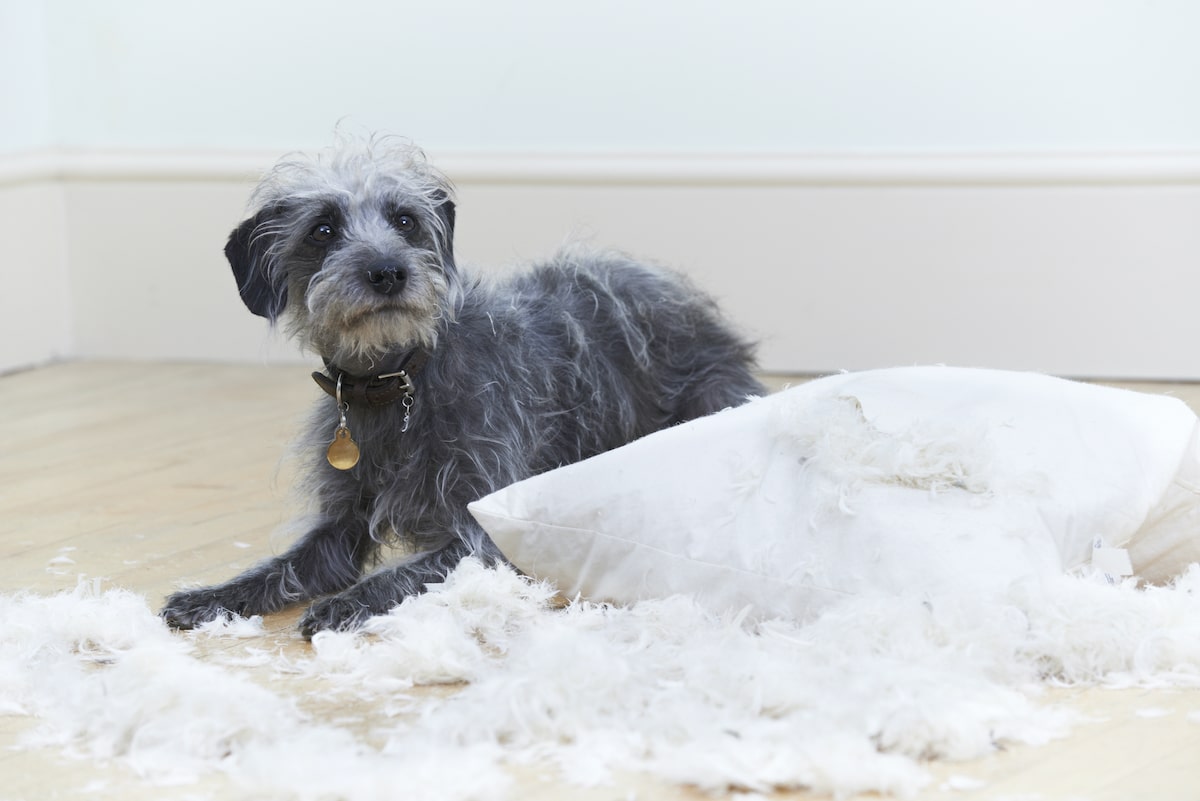
You’ve invited a few friends over. Everyone is enjoying your fine-tasting snacks when someone suddenly asks: “Hey, where’s your dog Scruffy? Why don’t you let him out so he can hang with us?”
You politely decline, convinced that your friends would be better off without dealing with Scruffy’s begging habits, his desire to lick everyone's face, and his constant need for playing tug-of-war. If only Scruffy was more well-mannered…
But is there such a thing as “good” dog manners?
YES, there is! We’re going to show you how to teach your dog good manners in this article.
However, before we dive into teaching your dog good manners, we should look at a few common dog behavioral issues first.
Common Unruly Behaviors
It’s one thing to have a happy, excited dog. It’s another thing to mistake that excitement for unruly behavior. But as dog owners, it’s easy to mix the two up.
The truth is, “bad” dog behavior comes in all shapes and sizes…
- Leash pulling
- Jumping on people
- Destructively chewing household items
- Stealing food from the countertops
- Excessive barking
- Mounting (humping) on people, furniture, or other dogs
- Mouthing or play biting on people and other dogs
- Food guarding
More serious dog behaviors, like dog aggression, separation anxiety, and uncontrollable barking require a deeper understanding and may need supplemental intervention.

But if you truly think that the common unruly dog behaviors listed above are just a reflection of your dog's unique personality, then you're doing yourself and your sweet canine friend a disservice.
Think about it…
If your dog's constant barking, or jumping on people, drives you up a wall now, don’t assume it will get better with time. That bad behavior will only continue to aggravate you.
Before you know it, you’re so aggravated at your dog's unruly behavior that you respond by keeping them out of view any time people come over. Meanwhile, your poor pup is left to wonder what they did so wrong to cause this abrupt solitude.
So, what gives? How do you train an unruly dog?
How to Teach Your Dog Basic Manners
There’s a common misconception that you need to block off a certain amount of time to train your dog. While that might be helpful, the truth is you can train your dog at any time.
Training your dog to be well-mannered and well-socialized takes consistency, repetition, and practice. Practicing new skills and habits actually benefits your dog’s well-being. It gives them purpose; if their owner is happy, they often are, too.
The key to teaching your dog good manners is to keep all interactions fun.
Don’t attempt to train your dog when you’re stressed out or having a bad day. Dogs are incredibly sensitive to their owners’ emotions.
Now, let’s start with the basics…
The 3 Dog-Training Essentials
Sit. Stay. Wait. Down. Leave it.
These are the most common commands pet owners want their dogs to learn. These are the foundation of good dog manners. The best part is, they’re also easy to teach your dog.
Here are three dog training techniques every dog owner should learn:
- Luring –– Use a treat to lure your dog into different behaviors. For example, hold a treat to your dog’s nose and slowly move it down until your dog stays. This is an effective method for training your dog to sit.
- Capturing –– Give a treat when your dog performs a natural behavior on cue. For example, when your dog lies down on their own, immediately use a verbal command like “lay down”, or a hand signal, and reward them as fast as you can.
- Shaping –– Reward your dog through a series of steps when teaching them a new trick or behavior. For example, teaching your dog to willingly go into their crate may take a series of steps. Reward your dog every step of the way until they are comfortable being in their crate.
Notice anything about these techniques? They’re all positive.
Positive reinforcement is the most powerful tool for changing a problem behavior. Think training treats, hand gestures, or words of affirmation, like “good boy” or “good girl”.

It makes sense that positive reinforcement is more effective than negative reinforcement…
When you do a good job at something, doesn't it feel good when someone says, “Good job”? It makes you want to keep doing it, right?
The same concept applies to your canine family member. The more excited we get when our dog does something right, the more our dog wants to keep doing it.
This is because our body language has a huge influence on our dog's mind.
For example, if you’re out walking your dog and someone asks to pet them, staying calm and using the phrase “good boy” or “good girl” can really help calm them down and reassure them that the stranger just wants to love on them.
Speaking of dog walking, let’s look at…
How to Teach Your Dog Leash Manners
Walking your dog outside is like taking them to the carnival. There are thousands of distractions; Lots of noise, squirrels running from tree to tree, other people walking their dogs, and even tasty food scraps.
So, it's our job as pet owners to be MORE aware of the surroundings than our dogs are. Since most dogs are driven by food, having training treats on hand can help to keep their attention on us. Verbal reinforcement works, too (“good boy” & “good girl).
In the event that a distraction does trigger bad behavior, command your dog to sit, then proceed to love on them. This will help calm their anxious behaviors and refocus their attention back onto you.
We also recommend you use a short leash, especially when approaching other dogs.
Sure, your dog might be friendly, but you never know what’s going on in another dog's brain. So, keep a short leash and a healthy distance, too… just until you know it’s safe to proceed.
There’s one last thing we’d like to point out about leash manners…
Dog owners don’t realize it, but when they’re tense and they pull back on the leash, they’re inadvertently putting their dog on alert.
We’ve all done it; pulling on the leash is a natural reflex. But instead of pulling on the leash, try using verbal commands to get your dog’s attention. This will prevent any negative alertness and possible neck or back injury.
Learning Good Manners at Home
Good house manners can mean different things in different households. In one home, it’s acceptable for a dog to lay on the couch, in another home, it’s 100% forbidden.
Both of those are fine, so long as it’s clear to the dog what constitutes “acceptable” behavior. Again, consistency is key!
If you don’t want your dog on the couch and you live with other people, then you’ll need to ensure that everyone in the house is enforcing the “no couch” rule. If not, then your dog will get confused.
Using the command “wait” can really prevent your dog from getting overly excited about going outside or eating meals. Especially when guests are over.
“Down” is a great command if you have a dog who jumps on people. It also helps to prepare guests to ignore and turn around if your dog does jump.
And if you happen to have snacks out, use the command “leave it” to deter your dog from stealing a few squares of cheese and crackers.
In the event that children are around, using the command “gentle” can help teach your dog to be extra cautious. But it’s important to note that not every child knows how to approach or pet a dog. If a kid is pulling on a dog's tail and ears, the pain can cause your dog to react in a negative way.

Unless the child is taught to be gentle with a dog, it may be best to prevent their interaction altogether.
That said, it helps to designate a safe place in the house for your dog to relax. It could be their crate, their dog bed, a spot on the couch, or a stretch-out spot next to the sliding door.
Commanding your dog to go to their “place” can keep them out of the way when guests are over, while still allowing them to feel they’re a part of what's going on.
Lastly…
How to Control Barking
Let’s face it, some dogs are more verbal than others. But barking, in general, can be very annoying, especially indoors.
Now, there may be a reason behind your dog’s barking. It could be a lack of exercise, separation anxiety, the need to go potty, it’s dinner time, or maybe there’s someone at the door. But if none of these reasons are the case, there may be something more serious going on. In this case, supplemental intervention may help.
If after a full assessment you find there’s nothing serious going on, then you may have a case of what trainers call “demand barking” on your hands.
This is when your dog barks and barks and barks to get your undivided attention, or a treat, or for you to open the door, etc. Unfortunately, toy breeds and smaller adult dogs tend to inherit this bad behavior. And, often, their owners unwittingly encourage it.
Demand barking might be hard to stop, but it can be done. It’s best to start shaping barking during puppy training, but it’s possible to make advancements later on, too.
Ignoring them can help deter them from yapping their head off. But there are other tips for training your dog to not bark as well, like focusing their attention on other quiet behaviors.
Key Training Takeaways
In the beginning, training your dog to have good manners takes a lot of work and patience. And we know that some of the advice above is easier said than done. Again, practice makes perfect. If you stay consistent, sooner than later, you’ll start to see positive change in your dog.
Remember, set your dog up for success by keeping your training session and interactions full of fun and positive reinforcements! If you have any questions or concerns, reach out to our Lolahemp team, we’d love to hear from you.
References:
https://www.aspca.org/pet-care/dog-care/common-dog-behavior-issues
https://lolahemp.com/blogs/news/cbd-oil-dog-aggression?_pos=8&_sid=b72a2ab71&_ss=r
https://lolahemp.com/blogs/news/treating-separation-anxiety-dogs?_pos=7&_sid=6e356b8ce&_ss=r
https://lolahemp.com/blogs/news/how-to-stop-my-dog-from-barking-training-tips?_pos=3&_sid=6e356b8ce&_ss=r
https://lolahemp.com/collections/all-products/products/lolahemp-cbd-300mg-30ml-tincture
https://www.semanticscholar.org/paper/Are-dogs-sensitive-to-the-emotional-state-of-humans-Morisaki-Takaoka/c0a4314603bb1b219c1b9859b4be419d94deb939
https://lolahemp.com/blogs/pet-training-tips/luring-capturing-and-shaping-three-dog-training-techniques-every-dog-owner-should-learn?_pos=6&_sid=6e356b8ce&_ss=r
https://lolahemp.com/collections/all-products/products/omega-hemp-soft-chews
https://lolahemp.com/collections/all-products/products/lolahemp-cbd-300mg-30ml-tincture
https://lolahemp.com/blogs/news/how-to-stop-my-dog-from-barking-training-tips?_pos=3&_sid=4c961df0f&_ss=r
https://lolahemp.com/blogs/pet-training-tips/how-to-set-your-dog-up-for-success-when-training?_pos=4&_sid=3fe1f833f&_ss=r
https://lolahemp.com/pages/contact-us

